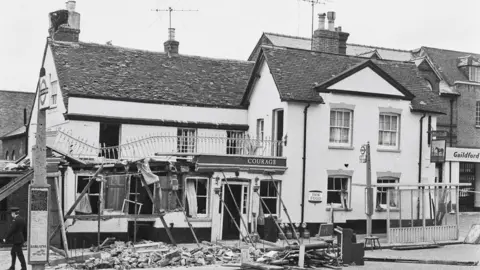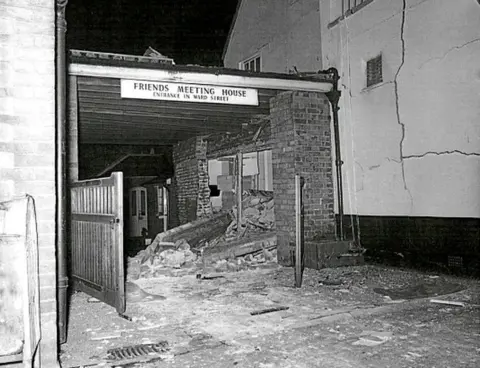Guildford pub bomb inquests: Building could have collapsed in IRA bomb
 Getty Images
Getty ImagesA soldiers' pub that was bombed by the IRA in 1974, killing five people, could have collapsed in the blast, a Porton Down expert has told an inquest.
Lorna Hills said a high-explosive detonation created a shock wave in the Horse and Groom in Guildford.
She said a wall fell, allowing gas to escape. If that didn't happen, the gas would have bounced back and potentially injured more people in the packed pub.
Two pubs in the town were attacked on 5 October, and 65 people were injured.
The hearing was told how extension work had been carried out in the Horse and Groom and how a brick wall that had been part of an extension fell down.
Ms Hills said: "The building could have suffered a complete collapse as a result of this explosion.
"The wall essentially fell down and this allowed gas to escape. If that hadn't have failed, gas would have bounced back in and potentially injured more people."
 HM Coroner
HM CoronerOliver Sanders, counsel to the inquest, said it was "fortuitous" the bomb wasn't "contained" inside the building.
The Guildford Four and Maguire Seven were wrongly-convicted of carrying out the attack before the IRA claimed responsibility.
Those who died in the bombing were 21-year-old civilian Paul Craig and soldiers Ms Hamilton, 19, Ms Slater, 18, William Forsyth, 18, and John Hunter, 17.
 Handout
HandoutMs Hills, a principal case worker for the Forensic Explosives Laboratory at DSTL (Defence Science and Technology Laboratory), which is part of the Ministry of Defence, was appearing as an independent witness.
The inquest heard DSTL was at one time known as Rarde (Royal Armament Research and Development Establishment), which was involved in the criminal investigation into the Guildford pub bombs in the 1970s, and DSTL holds the original case file.
Her report was a review of documents compiled by Metropolitan police officer Maj Donald Henderson and two scientists at the time Douglas Higgs and Donald Lidstone.
The inquest heard a fragment of a Smith's pocket watch was found at the scene.
The 10lb (4.5kg) nitroglycerine-based bomb would have weighed the same as four full bottles of wine - but could have fit in a rucksack or bag.
Ms Hills said no additional shrapnel was added to the device and the inquest heard this may be because none was available, or it would have made the device heavier to carry.
The hearing was told that Ms Hills's report also contained details of correlation evidence linking the blast with other IRA incidents where Smith's pocket watches were used, but the information was out of the scope of the inquest.
Mr Sanders said one matter not relevant to the inquest was that there had been a dispute in the original trial over whether the bomb had been in a brown bag or not.
He said Mr Higgs and Mr Lidstone had agreed "whatever it was, there was nothing left of it" after the explosion.
The hearing continues.

Follow BBC South East on Facebook, on Twitter, and on Instagram. Send your story ideas to [email protected].
